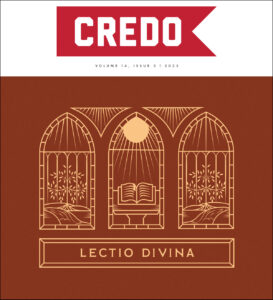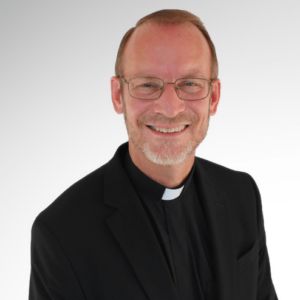
Longing for God Himself
L ectio divina literally means “divine reading” or we might say that it is a kind of “holy reading,” a reading of the Christian Scriptures that accords with their “divine character,” to borrow a phrase from Hans Boersma.[1] These days the phrase is bandied about in such a way that it gives the appearance that lectio divina is some sort of a program, one option or method of reading God’s Word among others. This may be the case today but historically lectio divina was just the way to read the biblical text. It was not a unique way of reading but the common way of reading the Word of God. It involved (1) reading, (2) prayer, (3) meditation, and (4) contemplation. We would be well served to return to this historical, classical understanding of the term, lest we too get caught up in thinking that lectio divina is a new program that we could (or should) introduce into our congregations.Historically lectio divina was just the way to read the biblical text. Click To Tweet
ectio divina literally means “divine reading” or we might say that it is a kind of “holy reading,” a reading of the Christian Scriptures that accords with their “divine character,” to borrow a phrase from Hans Boersma.[1] These days the phrase is bandied about in such a way that it gives the appearance that lectio divina is some sort of a program, one option or method of reading God’s Word among others. This may be the case today but historically lectio divina was just the way to read the biblical text. It was not a unique way of reading but the common way of reading the Word of God. It involved (1) reading, (2) prayer, (3) meditation, and (4) contemplation. We would be well served to return to this historical, classical understanding of the term, lest we too get caught up in thinking that lectio divina is a new program that we could (or should) introduce into our congregations.Historically lectio divina was just the way to read the biblical text. Click To Tweet
The Contemplative Life of Leisure
The roots of what we now know as lectio divina are rooted in pre-Christian practices and philosophies, especially those current among Greek philosophers. In Greek philosophy, education (Gr. paideia) refers to the transformation of the whole student (body-mind-heart-soul). To achieve this paideia the student needed to engage in a life of leisure; that is, have the freedom to wonder, to experience wisdom. This life of leisure (Gr. skole = “school” in English) was not like our idea of “vacation” but refers to a subjective experience where the student is given the freedom, the space, the leisure to be wholly present to what she is beholding, or studying. This leisure was seen as a life of contemplation (theōria) wherein one had the privilege of searching for meaning, which constitutes wisdom. Though theōria literally means “witnessing a spectacle” (which Aristotle claims is a completely useless thing to do), in time it gained the more positive connotation of contemplation as the processes of gaining wisdom. The theōri (“lover of spectacles”) in Plato (Republic 475e) became the “lover of the spectacle of truth.” As Mary Keator reminds us, in Ancient Greek philosophy theōria was a knowing by seeing and experiencing (as in a spectacle) as opposed to knowing only about something or how to do something.[2] In contemplation a person is drawn out of themselves into a search for goodness, truth, and beauty. In Greek philosophy, education refers to the transformation of the whole student. To achieve this, the student needed to engage in a life of leisure; that is, have the freedom to wonder, to experience wisdom. Click To Tweet
But how do we do this? How does one get to this theōria? The historical Christian answer comprises four practices: lectio, meditation, oratio and contemplation. Reading (lectio) is not, of course, a uniquely Christian activity. In the ancient world reading was a techné, a literary tool, used to glean ideas that would then be used in a face-to-face discussion. Reading awakens the power of reasoning. Discussing ideas was inferior to simply reading about them. Nonetheless, by the time of Christ, and especially in the apostolic era, reading took on an important element in early Christian worship and spiritual practices. For example, the Apostle Paul writes to Timothy, “devote yourself to the public reading of Scripture, to exhortation, to teaching” (1 Tim. 4:13; ESV). We can see here an echo of ancient Greek practice wherein reading leads to discussion or talking (exhortation and teaching). But mostly what we see is that the early Christians continued to do the same kind of things that the Jews did in their own worship. Recall Acts 13:15: “After the reading from the Law and the Prophets, the rulers of the synagogue sent a message to them, saying, ‘Brothers, if you have any word of encouragement for the people, say it’” (ESV), or Luke 4:17-18, 20: “And the scroll of the prophet Isaiah was given to [Jesus]. He unrolled the scroll and found the place where it was written, ‘The Spirit of the Lord is upon me…’ And he rolled up the scroll and gave it back to the attendant and sat down. And the eyes of all in the synagogue were fixed on him” (ESV). Reading aloud from the scriptures were part and parcel of Second Temple worship, and so it became the same for the early Christian communities.
Meditation: The Means of Receiving Instruction
But this reading was not to be merely an oracular or auricular experience for one was to use the readings to teach. Thus, after lectio comes meditation. Like lectio, meditatio was a techné to the ancient philosophers. Perhaps the concept of meditation conjures up images of people sitting in a circle, adopting a particular posture while thinking quietly to themselves. That too is a kind of meditation, but it is not meditatio that follows lectio. According to Guigo II the Carthusian (d. 1188), in his Ladder of Monks, meditation is “the busy application of the mind to seek with the help of one’s own reason for knowledge of hidden truth.”[3] But we do not meditate only with our own reason but with the aid of the Holy Spirit. In the Anglican tradition there is a well-known Collect (prayer) for the Second Sunday of Advent that seems to express well the concept of meditatio: “Blessed Lord, who hast caused all holy Scriptures to be written for our learning; Grant that we may in such wise hear them, read, mark, learn, and inwardly digest them, that by patience and comfort of thy holy Word, we may embrace, and ever hold fast, the blessed hope of everlasting life, which thou hast given us in our Savior Jesus Christ. Amen.” Notice first the language of hearing and reading, corresponding to lectio. Meditatio seems to be encapsulated in the phrase “inwardly digest them.” This collect, composed by Thomas Cranmer for the 1549 Book of Common Prayer, is based on Romans 15:4 ‒ “For whatever was written in former days was written for our instruction, that through endurance and through the encouragement of the Scriptures we might have hope” (ESV). The use of the word “learning” in the Collect does not mean memorization but “instruction.” Thus, we hear God’s Word, read it, mark it, and are instructed by it. This “instruction” by the Word is intimately connected to the work of Christ, our Teacher, and the Holy Spirit, our Illuminator.
The language of “digest” suggests the activity of eating, and eating suggests chewing. Thus, the primary activity of meditation is ruminatio, which is an image of regurgitation, of digesting food. Gregory the Great (d. 604), in his Pastoral Care, wrote that the “mind is commonly signified by the term ‘belly’ because, as the belly consumes food, so the mind assimilates the cares by brooding over them. We are taught that the mind is called the belly by that sentence in which it is written: The spirit of a man is the lamp of the Lord, which searches all the hidden things of the bowels [Prov. 20:27]. This as if it had been said that the illumination of divine inspiration, entering the mind of man, shows the mind to itself by enlightening it.”[4] Similarly, Hugh of St. Victor (d. 1141) says that we need “to recall the principles we have gleaned from our readings from the stomach of memory to taste them.” In other words, to “inwardly digest” is to ruminate, to chew the cud, if you will, of the Scriptures so that we are nourished by the words and our minds are fed and nourished with the truth of God’s Word. For “there is nothing that so much strengthens our faith and trust in God, that so much keeps up innocence and pureness of the heart, and also of outward godly life and conversation, as continual reading and recording of God’s word” (from the sixteenth-century homily “A Fruitful Exhortation to the Reading of Scripture”).

